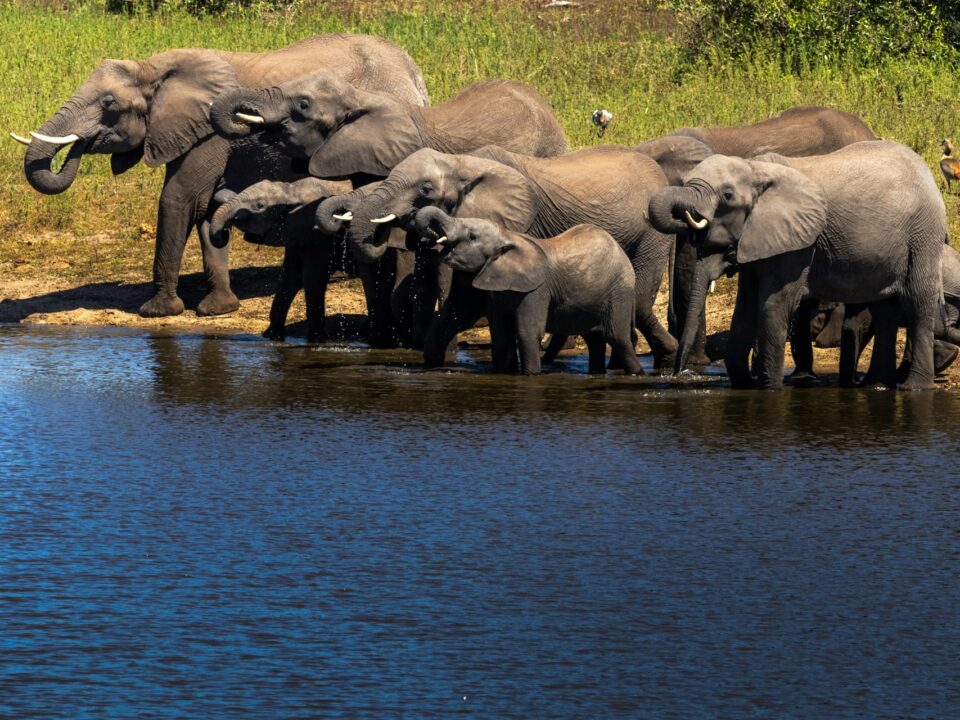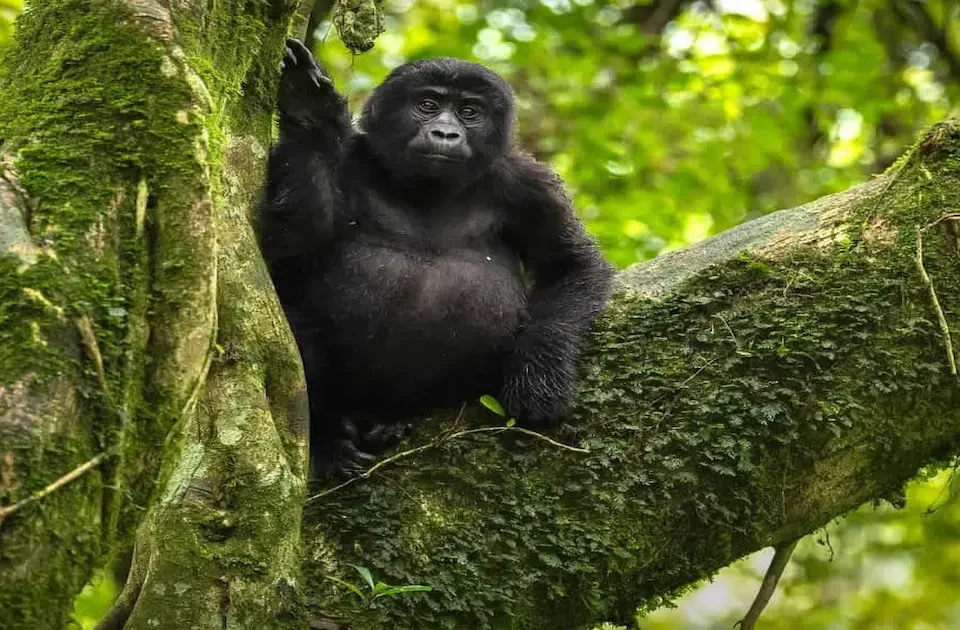A Big Five safari is a journey focused on the pursuit of spotting Africa’s five most iconic animals: the lion, leopard, elephant, rhino, and buffalo. Originally a term from big-game hunters, this celebrated “checklist” has transformed into the ultimate sighting goal for wildlife enthusiasts and photographers. It’s an adventure that combines the thrill of a search with the reward of seeing these magnificent creatures in their natural habitat.
In this guide, we’ll introduce you to each of the Big Five, highlight where to see them across Africa, and explain why Uganda offers a unique safari experience that goes beyond the ordinary.
(Image 1: A collage of the five animals—lion, leopard, elephant, buffalo, rhino—in their natural habitat.)
- Alt-text: The Big Five: A collage showing a lion, leopard, elephant, rhino, and buffalo on an African safari.
The Big Five: Meet the Icons
- The Lion: Known as the “King of the Jungle,” lions are the most social of the big cats, living in family groups called prides. Seeing a pride hunt or simply laze in the sun is a powerful and iconic safari moment. In Uganda, lions are most frequently spotted in the savannah parks.
- The Leopard: The most elusive and solitary of the Big Five, the leopard is a master of camouflage. They are primarily nocturnal and are often seen resting in the branches of acacia trees, where they secure their prey from other predators. Spotting a leopard requires patience and a sharp-eyed guide.
- The African Elephant: The largest land animal on Earth, the African elephant is an awe-inspiring sight. These gentle giants are highly intelligent and live in complex matriarchal societies. Their impressive size and social interactions make them a safari highlight.
- The African Buffalo: A powerful and unpredictable herbivore, the African buffalo is known for its formidable strength and impressive horns. They are often found in large herds near water sources, and their collective presence can be overwhelming and spectacular.
- The Rhino: The most endangered of the five, a symbol of conservation efforts. The most threatened of the Big Five, rhinos were driven to extinction in Uganda due to poaching. However, a dedicated conservation effort has successfully reintroduced them. Because of their vulnerable status, they are the most challenging of the five to see in the wild, requiring a visit to a specialized sanctuary.
Where to Experience a Big Five Safari
The African continent is vast, offering a variety of landscapes and safari styles. Certain countries are world-renowned for their Big Five concentrations and are often considered the “classic” safari destinations.
- Tanzania: Home to vast plains and the Great Migration.
- Serengeti National Park: Famous for the annual wildebeest migration and high concentrations of lions and leopards.
- Ngorongoro Conservation Area: A natural wonder where you can often see all of the Big Five in a single day within its collapsed volcanic caldera.
- Kenya: A classic safari destination with exceptional wildlife viewing.
- Maasai Mara National Reserve: Renowned for the Great Migration and its density of Big Cats, particularly lions.
- Amboseli National Park: A highlight for its huge elephant herds set against the backdrop of Mount Kilimanjaro.
- South Africa: Offers a variety of experiences from self-drive to luxury lodges.
- Kruger National Park: A flagship park known for its high density of the Big Five and excellent infrastructure for both self-drive and guided tours.
- Sabi Sand Game Reserve: A private reserve adjacent to Kruger, famous for its exceptional leopard sightings.
- Uganda: Known as “The Pearl of Africa,” Uganda provides a unique and diverse safari experience.
- Murchison Falls National Park: Uganda’s largest park, excellent for seeing the “Big Four” and featuring a spectacular waterfall.
- Queen Elizabeth National Park: Famous for its tree-climbing lions in the Ishasha sector and plentiful elephants and buffaloes.
- Ziwa Rhino Sanctuary: The only place in Uganda to see rhinos in the wild through a dedicated, on-foot tracking experience.
The Big Five and Beyond: The Uganda Advantage
While other destinations are famous for their sheer numbers, Uganda offers a unique and intimate safari experience. Here, a Big Five safari is not just about a single-park game drive, but an exploration of diverse ecosystems. You can see the “Big Four” in the savannahs of Queen Elizabeth National Park and Murchison Falls National Park and then complete your list with an incredible rhino encounter at the Ziwa Rhino Sanctuary.
A rhino at Ziwa Rhino Sanctuary in Uganda, a key part of a Big Five safari.
But what truly sets Uganda apart is what lies beyond the Big Five. If you are looking for an adventure that goes deeper into the African wilderness, Uganda is the ultimate destination. This country offers the best primate experiences on the continent, earning it the title of “Primate Capital of the World.”
This is all thanks to Kibale National Park. With the highest concentration of primates in Africa, Kibale is home to over 1,500 chimpanzees, our closest living relatives. A chimpanzee trekking experience here is a thrilling and unforgettable adventure, a perfect counterpoint to the powerful presence of the Big Five.
(Image 3: A close-up shot of a chimpanzee in Kibale National Park.)
- Alt-text: A chimpanzee foraging in the lush forest of Kibale National Park, Uganda.
The Uganda Big Five Safari Experience
The vast majority of parks in Uganda are home to the “Big Four” (lion, leopard, elephant, and buffalo), but seeing a rhino requires a special stop.
- Murchison Falls National Park: As Uganda’s largest national park, Murchison Falls is a prime destination for a Big Five safari experience. The park is home to a healthy population of elephants, buffaloes, and lions. It’s also an excellent place to spot the elusive leopard, particularly on an evening game drive. The spectacular Murchison Falls and a boat cruise on the Nile River offer unique opportunities to see wildlife from a different perspective.
- Queen Elizabeth National Park: Located in the southwestern part of the country, Queen Elizabeth National Park is famous for its diverse ecosystems and, most notably, its tree-climbing lions in the Ishasha sector. It offers a fantastic chance to see the “Big Four” and is known for its large herds of elephants and buffalo. The Kazinga Channel boat cruise is a highlight, with hundreds of hippos and other animals lining the banks.
- Zziwa Rhino Sanctuary: To complete your Big Five safari, a visit to Zziwa Rhino Sanctuary is essential. Situated en route to Murchison Falls National Park, this sanctuary is the only place in Uganda with a wild rhino population. Here, you can enjoy a unique on-foot rhino tracking experience, led by an expert guide.


.
Tips for a Successful Big Five Safari
- Plan Ahead: Seeing all five animals on a single trip requires careful planning. It’s highly recommended to work with a knowledgeable safari operator who can create a custom itinerary that maximizes your chances of spotting each animal.
- Best Time to Visit: The dry seasons from June to August and December to February are generally considered the best times for a Big Five safari in Uganda. During these months, the vegetation is less dense, making wildlife easier to spot, and animals congregate around water sources.
- Pack Smart: Bring a good pair of binoculars, a camera with a powerful zoom lens, and neutral-colored clothing. Remember to be patient and listen to your guide, who knows the habits and territories of the animals.
The Adventure Awaits
A Big Five safari is more than just a trip; it’s a profound experience that connects you with the raw beauty and power of the African wilderness. From the thrill of spotting a leopard to the majesty of an elephant herd, this journey will create memories to last a lifetime.
Ready to see the Big Five for yourself? We can help you customize the perfect safari itinerary that combines the best of Uganda’s wildlife parks and conservation efforts.
FAQs About a Big Five Safari
- Is it really possible to see all five animals on one safari? While sightings are never guaranteed, a well-planned itinerary with a knowledgeable guide gives you the best chance of seeing all five.
- How close do you get to the animals? Guides are trained to maintain a safe and respectful distance. You will get close enough for excellent photos and views, but not so close as to disturb the animals.
- Is a Big Five safari expensive? The cost varies widely depending on the country, length of stay, and level of accommodation. However, there are options to suit most budgets.
- Do I need special equipment? Binoculars are essential for close-up views. A camera with a telephoto lens is highly recommended.
Ready for Beyond the Big Five?
If you’re ready to go beyond the ordinary safari and experience the ultimate African adventure, Uganda is the spot. Our custom itineraries are designed to combine the classic Big Five safari with an unforgettable primate experience.



